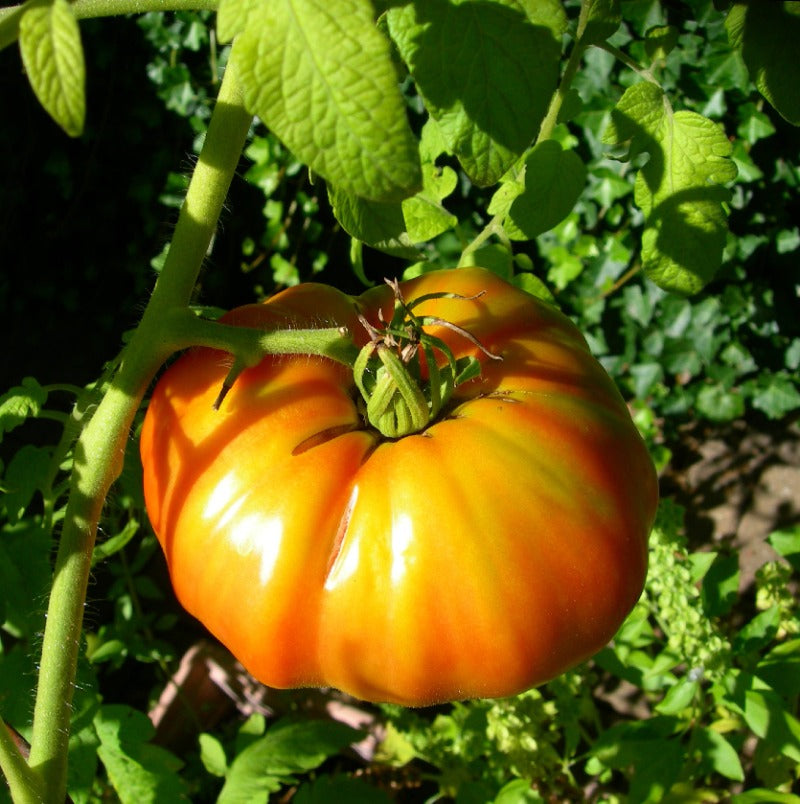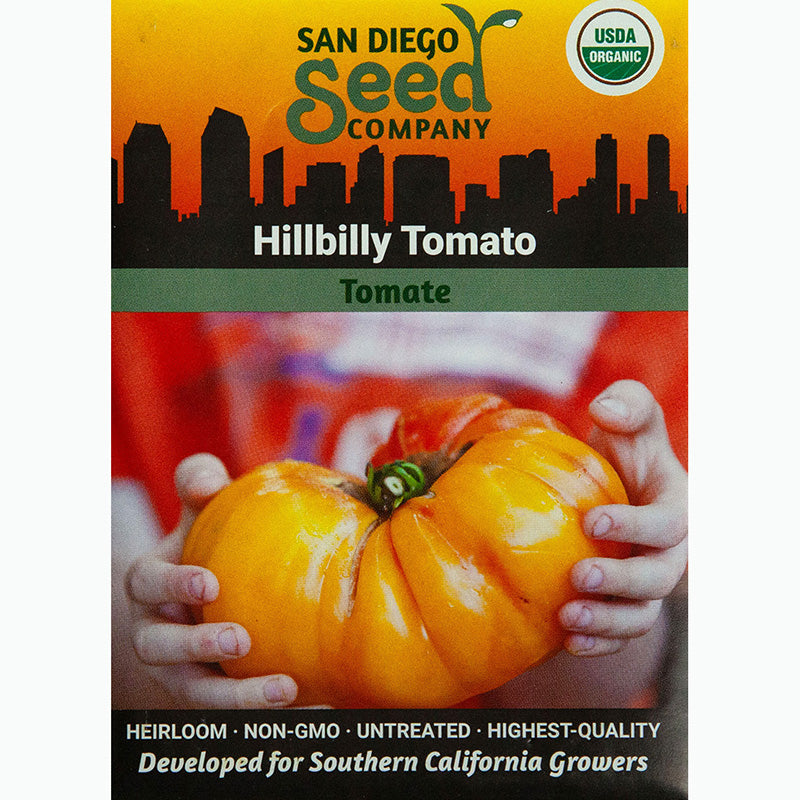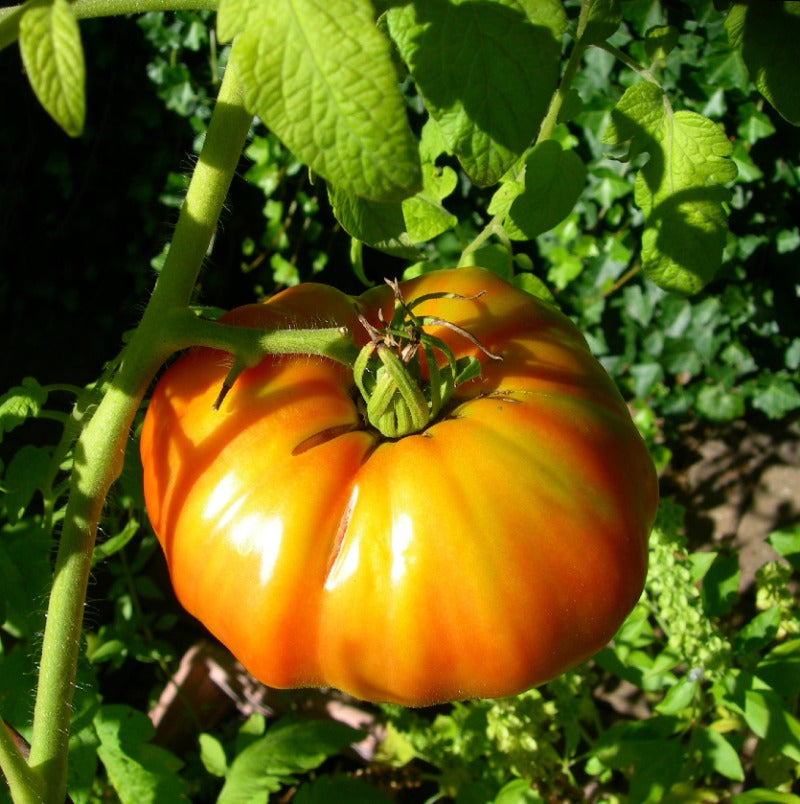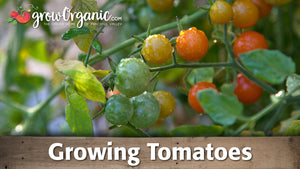Item Number: SNV1018
Hillbilly Tomato Seeds (Organic)
Hillbilly Tomato Seeds (Organic)
Marbled Flavor Wonder
Cultivating Hillbilly tomatoes offers a rewarding experience for gardeners seeking a unique and flavorful addition to their harvest. Here's a comprehensive guide on growing Hillbilly tomatoes:
Understanding Hillbilly Tomatoes:
Varietal Overview: Hillbilly tomatoes (Solanum lycopersicum) are large, beefsteak-type heirloom tomatoes known for their striking appearance with yellow-orange marbling and sweet, tangy flavor. Size and
Characteristics: These tomatoes often weigh up to 2 pounds or more, showcasing a ribbed and irregular shape, making them an eye-catching addition to any garden or plate.
Flavor Profile: Hillbilly tomatoes offer a delightful balance of sweetness and acidity, making them suitable for various culinary uses. Planting
Hillbilly Tomato Seeds:
Seed Selection: Choose high-quality seeds from reputable suppliers, ensuring they are suitable for your specific growing zone.
Timing: Start seeds indoors 6-8 weeks before the last expected frost date. Transplant seedlings outdoors after all risk of frost has passed.
Soil Preparation: Opt for well-draining, fertile soil rich in organic matter. Amend soil with compost for improved nutrients and moisture retention.
Spacing: Plant seedlings or sow seeds about 24-36 inches apart in rows spaced 36 inches apart to provide ample room for growth.
Ideal Growing Conditions and Zones:
Suitable Growing Zones: Hillbilly tomatoes thrive in USDA plant hardiness zones 4-9, encompassing various climates and temperature ranges conducive to healthy tomato growth. Sunlight: Ensure a minimum of 6-8 hours of direct sunlight for robust growth and fruit development.
Watering: Maintain consistent soil moisture levels, avoiding both drought stress and waterlogging to prevent issues like blossom-end rot.
Fertilization: Apply balanced fertilizer during planting and consider additional feeding during the growing season for vigorous growth.
Care and Maintenance:
Support: Provide sturdy support such as stakes or cages to ensure the sprawling vines are well-supported, preventing breakage and ensuring proper airflow.
Pruning: Regularly remove suckers and excess foliage to improve air circulation and focus the plant's energy on fruit production.
Weed Control: Keep the area around the plants free from weeds to minimize competition for nutrients and water.
Pollination and Fruit Development:
Pollination: Hillbilly tomatoes are self-pollinating but can benefit from pollinators like bees for better fruit development. Gentle shaking of the plants can aid in pollination.
Fruit Care: Monitor for pests and diseases, such as aphids or fungal infections. Utilize organic pest control methods to safeguard the developing fruits.
Harvesting Hillbilly Tomatoes:
Timing: Harvest when the tomatoes show their characteristic yellow-orange marbling and yield slightly to gentle pressure.
Harvest Technique: Use garden shears or a sharp knife to cut the tomatoes from the vine, ensuring a clean cut without damaging the plant. Storing and Usage: Storage: Store ripe tomatoes at room temperature away from direct sunlight and use them within a few days for optimal flavor.
Usage: Enjoy Hillbilly tomatoes in salads, sandwiches, sauces, or relish their unique flavor when sliced fresh. Growing Hillbilly tomatoes involves providing optimal growing conditions and attentive care. By following these guidelines, gardeners can enjoy the striking appearance and delightful taste of Hillbilly tomatoes, adding vibrancy and flavor to their garden harvest.


Check Your Zone Compatibility:
Compatible with your zone.
Growing Zone for
,

Our Guarantee To You
Since 1976, we've served our customers at every stage of growing. Please contact us at any time. We are happy to support and assist you.
Description
Description
Cultivating Hillbilly tomatoes offers a rewarding experience for gardeners seeking a unique and flavorful addition to their harvest. Here's a comprehensive guide on growing Hillbilly tomatoes:
Understanding Hillbilly Tomatoes:
Varietal Overview: Hillbilly tomatoes (Solanum lycopersicum) are large, beefsteak-type heirloom tomatoes known for their striking appearance with yellow-orange marbling and sweet, tangy flavor. Size and
Characteristics: These tomatoes often weigh up to 2 pounds or more, showcasing a ribbed and irregular shape, making them an eye-catching addition to any garden or plate.
Flavor Profile: Hillbilly tomatoes offer a delightful balance of sweetness and acidity, making them suitable for various culinary uses. Planting
Hillbilly Tomato Seeds:
Seed Selection: Choose high-quality seeds from reputable suppliers, ensuring they are suitable for your specific growing zone.
Timing: Start seeds indoors 6-8 weeks before the last expected frost date. Transplant seedlings outdoors after all risk of frost has passed.
Soil Preparation: Opt for well-draining, fertile soil rich in organic matter. Amend soil with compost for improved nutrients and moisture retention.
Spacing: Plant seedlings or sow seeds about 24-36 inches apart in rows spaced 36 inches apart to provide ample room for growth.
Ideal Growing Conditions and Zones:
Suitable Growing Zones: Hillbilly tomatoes thrive in USDA plant hardiness zones 4-9, encompassing various climates and temperature ranges conducive to healthy tomato growth. Sunlight: Ensure a minimum of 6-8 hours of direct sunlight for robust growth and fruit development.
Watering: Maintain consistent soil moisture levels, avoiding both drought stress and waterlogging to prevent issues like blossom-end rot.
Fertilization: Apply balanced fertilizer during planting and consider additional feeding during the growing season for vigorous growth.
Care and Maintenance:
Support: Provide sturdy support such as stakes or cages to ensure the sprawling vines are well-supported, preventing breakage and ensuring proper airflow.
Pruning: Regularly remove suckers and excess foliage to improve air circulation and focus the plant's energy on fruit production.
Weed Control: Keep the area around the plants free from weeds to minimize competition for nutrients and water.
Pollination and Fruit Development:
Pollination: Hillbilly tomatoes are self-pollinating but can benefit from pollinators like bees for better fruit development. Gentle shaking of the plants can aid in pollination.
Fruit Care: Monitor for pests and diseases, such as aphids or fungal infections. Utilize organic pest control methods to safeguard the developing fruits.
Harvesting Hillbilly Tomatoes:
Timing: Harvest when the tomatoes show their characteristic yellow-orange marbling and yield slightly to gentle pressure.
Harvest Technique: Use garden shears or a sharp knife to cut the tomatoes from the vine, ensuring a clean cut without damaging the plant. Storing and Usage: Storage: Store ripe tomatoes at room temperature away from direct sunlight and use them within a few days for optimal flavor.
Usage: Enjoy Hillbilly tomatoes in salads, sandwiches, sauces, or relish their unique flavor when sliced fresh. Growing Hillbilly tomatoes involves providing optimal growing conditions and attentive care. By following these guidelines, gardeners can enjoy the striking appearance and delightful taste of Hillbilly tomatoes, adding vibrancy and flavor to their garden harvest.
Shipping Information
Shipping Information
Cannot ship to the following states: AK, HI, PR, VI, GU
Shipping Weight: 0.01 lb
Dimensions: 4.5"L x 3.25"W x 0.1"H
Features
Features
- Attracts Bees/Butterflies
- Greenhouse Compatible
- Grow on a Trellis
- Heirloom
- Requires Staking
- Requires Summer Water
Characteristics
Characteristics
Planting & Care
Planting & Care
Soil and Water: Tomatoes love fertile soil rich in organic matter. Add plenty of compost prior to planting. Soil pH is preferred between 5.5-7.0. Mulch to preserve moisture. Avoid wetting the foliage when watering.
Planting and Growing: Sow seeds in flats 6-8 weeks before the last frost and thin to 2" apart after the first true leaves appear. Before transplanting after the last frost, harden off the plants by placing them outdoors for a few hours to start, increasing the amount of time each day until they are accustomed to a full day of sunlight.
Harvesting and Storage: Harvest when fruits give slightly under finger pressure; the shoulders may not have changed color yet.
Useful Information
Useful Information
Guarantee
Guarantee
Share





